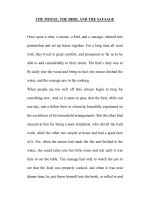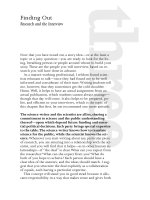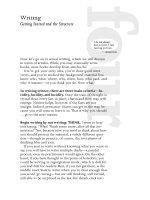fred and the ball
Bạn đang xem bản rút gọn của tài liệu. Xem và tải ngay bản đầy đủ của tài liệu tại đây (14.98 MB, 28 trang )
Teachering VersionTeaching Version
Untitled-22 T2Untitled-22 T2 6/6/05 4:06:45 PM6/6/05 4:06:45 PM
Untitled-22 T3Untitled-22 T3 6/6/05 4:06:47 PM6/6/05 4:06:47 PM
Rigby Flying Colors
Teaching Version Yellow
Text © 2003 Nelson Australia Pty Ltd
Photographs © 2003 Nelson Australia Pty Ltd
Originally published in Australia by Thomson Learning Australia
U.S. Edition © 2006 Harcourt Achieve Inc.
All rights reserved. No part of the material protected by this copyright may be reproduced
or utilized in any form or by any means, in whole or in part, without permission in writing
from the copyright owner. Requests for permission should be mailed to: Copyright Permissions,
Harcourt Achieve Inc., P.O. Box 27010, Austin, Texas 78755.
Rigby and Steck-Vaughn are trademarks of Harcourt Achieve Inc. registered in the
United States of America and/or other jurisdictions.
1 2 3 4 5 6 7 8 9 10 121 09 08 07 06 05
Printed in China/United States of America.
Fred and the Ball: Teaching Version
ISBN 1-4189-0901-7
Untitled-22 T4Untitled-22 T4 6/6/05 4:06:48 PM6/6/05 4:06:48 PM
T1
Overview
Fred and the Ball
A girl and her dog must retrieve a lost ball.
Reading Vocabulary Words High-Frequency Words
shouted said ball
gate new but
under here into
over went
Building Future Vocabulary
* These vocabulary words do not appear in this text. They are provided
to develop related oral vocabulary that fi rst appears in future texts.
Words: throw close lost
Levels: Gold Turquoise Blue
Comprehension Strategy
Drawing conclusions
Fluency Skill
Emphasizing words in
boldface
Phonics Skill
Identifying and reading
contractions (can’t)
Reading-Writing
Connection
Making a list
Home Connection
Send home one of the Flying
Colors Take-Home books for chil-
dren to share with their families.
Differentiated Instruction
Before reading the text, query
children to discover their level
of understanding of the compre-
hension strategy — Drawing
conclusions. As you work together,
provide additional support to
children who show a beginning
mastery of the strategy.
Focus on ELL
• Hold up a ball for the children.
Ask them to show how they
would throw the ball. Ask them
to show how they would kick
the ball. Show them the differ-
ence between throw and kick.
• Discuss different sports and
games that use balls.
Untitled-14 T1Untitled-14 T1 5/31/05 1:20:08 PM5/31/05 1:20:08 PM
1
T2
This Teaching Version will assist you in directing
children through the process of reading.
1. Begin with Before Reading to familiarize
children with the book’s content. Select the
skills and strategies that meet the needs of
your children.
2. Next, go to During Reading to help children
become familiar with the text, and then to
read individually on their own.
3. Then, go back to Revisiting the Text and
select those specifi c activities that meet
children’s needs.
4. Finally, fi nish with Assessment to confi rm
children are ready to move forward to the
next text.
Before Reading
Using This
Teaching Version
2. During Reading
4. Assessment
1. Before Reading
3. Revisiting
the Text
Building Background
• Write the word under on the board. Read it
aloud. Have children list things they can get
under. (tables, beds, trees) Have children
identify the opposite of under. (over)
• Introduce the book by reading the title, talking
about the cover illustration, and sharing the
overview.
Building Future Vocabulary
Use Interactive Modeling Card: Sentence Maker
• Introduce the word close. Ask What sorts of
things can you close? (doors, mouths, boxes)
• Write close at the top of the Sentence Maker. In
the fi rst box, write a sentence subject. Beneath
that, write a phrase using the word close. In
the fi nal box, write an entire sentence.
Introduction to Reading Vocabulary
• On blank cards write: shouted, gate, and under.
Read them aloud. Tell children these words
will appear in the text of Fred and the Ball.
• Use each word in a sentence for understanding.
Untitled-14 T2Untitled-14 T2 5/31/05 1:20:10 PM5/31/05 1:20:10 PM
2
T3
Book Talk
Beginning on page T4, use the During
Reading notes on the left-hand side
to engage children in a book talk. On
page 16, follow with Individual
Reading.
During Reading
Introduction to Comprehension Strategy
• Explain that drawing conclusions means that you
look for clues to fi nd information not directly
stated in the story.
• T ell children they will be drawing conclusions
about Fred and the Ball.
• Using the cover illustration, ask Does the girl like
playing with the dog? (yes) How do you know?
(She is smiling.)
Introduction to Phonics
• Write on the board: can, not. Read the words
aloud and use them together in sentences.
• Show children how to form the contraction
can’t from can not. Use can’t in a sentence.
• Together brainstorm other not phrases that
can become contractions: could not, should
not, is not, and will not. Write these on
the board. Show the children how to form
contractions with these words.
• Have children look for the word can’t as they
read Fred and the Ball.
Modeling Fluency
• Read aloud the fi rst sentence on page 5,
modeling emphasis of the boldfaced word.
• Talk about using boldfaced type to em-
phasize a word. Authors do this to show
something is important, to show something
is different, or to show someone is talking
more loudly than normal.
Untitled-14 T3Untitled-14 T3 5/31/05 1:20:15 PM5/31/05 1:20:15 PM
T4
During Reading
Book Talk
• Explain to children that drawing
conclusions means looking for clues
to fi nd information not directly stated
in a story.
• Comprehension Strategy Show
children the book cover. Ask What
two characters are in this book? (a
girl and a dog) What do you think
the dog’s name is? (Fred) How do
you know the dog’s name is Fred?
(because girls are not usually
named Fred)
• Discuss the cover. Ask children for
more clues. Ask What are Fred and
the girl doing? (playing with the ball)
Turn to page 2 — Book Talk
Untitled-14 T4Untitled-14 T4 5/31/05 1:20:16 PM5/31/05 1:20:16 PM
1
Revisiting the Text
Future Vocabulary
• Look at the cover illustration. Ask
Has Rosie
lost the red ball? (No, she
and Fred are playing with the ball.)
Now revisit pages 2–3
Untitled-14 1Untitled-14 1 5/31/05 1:20:19 PM5/31/05 1:20:19 PM
“Here you are, Fred,” said Rosie.
“This new ball is for you
to play with today.”
2
2
During Reading
Book Talk
• Ask Where are Rosie and Fred?
(in the yard) Is the
gate open? (no)
• Comprehension Strategy Ask How
does Fred feel? (happy or excited)
How do you know this? (He is wag-
ging his tail.) Why is Fred happy?
(because Rosie has a new ball
for him)
Turn to page 4 — Book Talk
Untitled-14 2Untitled-14 2 5/31/05 1:20:21 PM5/31/05 1:20:21 PM
3
3
Revisiting the Text
Future Vocabulary
• Ask What things can Rosie do with
the ball? (She can
throw it, kick it,
roll it, or hand it to Fred.) What
other games use balls? (baseball,
basketball, football, soccer, volleyball,
bowling) In which games would you
throw the ball? (baseball, basketball,
football) In which would you kick it?
(soccer) In which would you roll it?
(bowling)
Now revisit pages 4–5
Untitled-14 3Untitled-14 3 5/31/05 1:20:25 PM5/31/05 1:20:25 PM
Rosie kicked the ball to Fred.
“Jump up and get the ball, Fred!”
Rosie shouted.
4
4
During Reading
Book Talk
• Comprehension Strategy Ask Do
you think Rosie is strong? (yes) What
clues help you draw this conclusion?
(She can kick the ball high up into
the air and over the
gate.)
• Have children locate the word
shouted on these pages. Ask Why
has Rosie shouted? (because she is
excited)
• Fluency Skill Ask Why is the word
up in boldfaced type? (to give more
attention to it) Should you shout this
word? (No, just say the word a little
louder than normal.)
Turn to page 6 — Book Talk
Untitled-14 4Untitled-14 4 5/31/05 1:20:28 PM5/31/05 1:20:28 PM
5
The ball went up
and up and up!
It went over the gate
and into the grass.
5
Revisiting the Text
Future Vocabulary
• Say Rosie can kick the ball a long
way. Do you think you can
throw a
ball farther than you can kick it?
Now revisit pages 6–7
Untitled-14 5Untitled-14 5 5/31/05 1:20:31 PM5/31/05 1:20:31 PM
Rosie looked over the gate.
Fred looked under the gate.
6
6
During Reading
Book Talk
• Comprehension Strategy Ask What
is Fred doing now? (He is looking
under the gate.) Why can’t he get
the ball? (The gate is closed.) Does
Rosie have a key to the gate? (no)
How do you know this? (If she had
the key, she would unlock and open
the gate.)
• Have children locate the words
shouted and gate on these pages.
• Fluency Skill Read the sentences on
page 6. Ask Why is the word under in
boldfaced type? (It stresses that Fred
is doing something different from
what Rosie is doing. She is looking
over. He is looking under.)
Turn to page 8 — Book Talk
Untitled-14 6Untitled-14 6 5/31/05 1:20:33 PM5/31/05 1:20:33 PM
7
7
Revisiting the Text
Future Vocabulary
• Ask children why the gate might be
closed. Ask What other things can
you close? (door, box) What does it
mean to have a closed mind? (You
will not listen to new ideas.)
Now revisit pages 8–9
Untitled-14 7Untitled-14 7 5/31/05 1:20:36 PM5/31/05 1:20:36 PM
Rosie said to Fred,
“I can’t get over this gate.”
Fred made a big hole
under the gate.
8
8
During Reading
Book Talk
• Ask Why can’t Rosie climb over the
gate? (It is too high.) Why can’t she
crawl under the gate? (There is not
enough room.) What is Fred doing
now? (digging under the gate) Why?
(so they can fi nd the ball)
• Phonics Skill Have children locate
the word can’t on page 8. Remind
them of the contractions you dis-
cussed earlier in the lesson. Have
them read the sentence once with
can’t, and again with can not. Ask
What sounds do you hear in cannot
that you do not hear in can’t? (/n/
and o as in pot)
Turn to page 10 — Book Talk
Untitled-14 8Untitled-14 8 5/31/05 1:20:38 PM5/31/05 1:20:38 PM
9
9
Revisiting the Text
Future Vocabulary
• Ask What is Fred doing with the dirt?
(He’s
throwing the dirt out of the
hole.) What do we mean when we
say we will throw out the garbage?
(We will get rid of it.) Talk about the
difference between throwing some-
thing and throwing something away.
Now revisit pages 10–11
Untitled-14 9Untitled-14 9 5/31/05 1:20:41 PM5/31/05 1:20:41 PM
Fred went
under the gate.
Rosie went
under the gate, too.
10
10
During Reading
Book Talk
• Comprehension Strategy Ask Has
Rosie found the ball? (no) How do
you know this? (She asks Fred to fi nd
the ball.)
• Fluency Skill Have children locate
the boldfaced word on page 11. Ask
Why is the word please in boldfaced
type? (Rosie says this word loudly
because she very much wants Fred’s
help.)
• Comprehension Strategy Ask How
does Rosie feel? (frustrated) How do
you know this? (She is begging Fred
for help.)
• Have children locate all instances of
the words
under and gate on these
pages.
Turn to page 12 — Book Talk
Untitled-14 10Untitled-14 10 5/31/05 1:20:44 PM5/31/05 1:20:44 PM
11
“Where is the ball, Fred?”
said Rosie.
“Please help me look for it.
Please get the ball, Fred!”
11
Revisiting the Text
Future Vocabulary
• Say Rosie has lost the ball. How does
this make Rosie feel? (anxious) Have
you ever
lost anything? Did you fi nd
it again? Encourage children to use
the word lost as they share their
experiences.
• Ask How does it feel after you have
lost a game? How does it feel to
have had a fi ght and lost a friend?
Now revisit pages 12–13
Untitled-14 11Untitled-14 11 5/31/05 1:20:46 PM5/31/05 1:20:46 PM
Rosie looked in the grass.
“I can’t see the ball,” she said.
“It is not down here.”
Fred looked in the grass, too.
Fred saw the ball
in the grass by the tree.
12
12
During Reading
Book Talk
• Comprehension Strategy Ask Why
can’t Rosie see the ball? (She is look-
ing for it in the wrong place.) Does
Fred fi nd the ball? (yes) What clues
tell you Fred has found the ball? (He
barks and looks at the ball.)
• Phonics Skill Have children fi nd the
word can’t on page 12. Remind them
of the contractions you discussed
earlier in the lesson. Tell them that
people often use contractions when
speaking but often spell out both
words when writing.
Turn to page 14 — Book Talk
Untitled-14 12Untitled-14 12 5/31/05 1:20:49 PM5/31/05 1:20:49 PM
13
13
Revisiting the Text
Future Vocabulary
• Say Once you have lost something
in your house, how do you fi nd it
again? (look in other places) If you
have
lost a game, what do you do?
(practice more for the next game) If
you have lost a friend, what do you
do? (make up)
Now revisit pages 14–15
Untitled-14 13Untitled-14 13 5/31/05 1:20:51 PM5/31/05 1:20:51 PM
Fred ran back to the gate
with the ball in his mouth.
He went under the gate.
14
14
During Reading
Book Talk
• Ask Who has the ball now? (Fred)
Where is Fred going? (
under the
gate and back into the yard)
• Comprehension Strategy Ask How
does Fred feel now? (happy) How
do you know Fred is happy? (He is
wagging his tail.)
Turn to page 16 — Book Talk
Untitled-14 14Untitled-14 14 5/31/05 1:20:54 PM5/31/05 1:20:54 PM
15
15
Revisiting the Text
Future Vocabulary
• Ask Why doesn’t Rosie throw the
ball back over the gate? (because
Fred has the ball now)
• Talk about what Rosie will do next.
Ask Do you think she will kick the
ball again or
throw it instead?
Go to page T5 —
Revisiting the Text
Untitled-14 15Untitled-14 15 5/31/05 1:20:56 PM5/31/05 1:20:56 PM
Rosie looked over the gate.
“Good boy, Fred!” she said.
“You got the ball for me.”
16
16
During Reading
During independent work time,
children can read the online
book at:
www.rigbyfl yingcolors.com
Book Talk
• Leave this page for children to
discover on their own when they
read the book individually.
Individual Reading
Have each child read the entire book at
his or her own pace while remaining in
the group.
Go to page T5 —
Revisiting the Text
Untitled-14 16Untitled-14 16 5/31/05 1:20:59 PM5/31/05 1:20:59 PM
3
T5
Revisiting the Text
Future Vocabulary
• Use the notes on the right-hand pages to
develop oral vocabulary that goes beyond the
text. These vocabulary words fi rst appear
in future texts. These words are:
throw, close,
and lost.
Turn back to page 1
Reading Vocabulary Review
Activity Sheet: Clues to Use
• Discuss the different kinds of clues to look for
on Clues to Use. Give examples of each type
of clue.
• Have children complete the chart for the
words shouted, gate, and under.
Comprehension Strategy Review
Use Interactive Modeling Card: Story Map
• Together use the Story Map to outline Fred
and the Ball.
• Ask children to draw a conclusion about Fred
based on his solution to the story’s problem.
(Fred is an intelligent dog.)
Phonics Review
• Write can not on the board. Ask children to
make a contraction from these words.
• Have children fi nd the word not in the text.
(page 12) Ask them to make a contraction
from is not.
Fluency Review
• Remind children how to read boldfaced words.
• Write on the board Here is my book and make
my very dark. Model how to emphasize my by
reading it loudly, softly, slowly, and quickly.
Reading-Writing Connection
Activity Sheet: Making Conclusions
To assist children with linking reading and writing:
• Ask children if Rosie lives in a large city.
(probably not) Have them use the Activity
Sheet to make other conclusions about Rosie’s
home, using story details.
• Have each child write a list of adjectives that
describe where Rosie lives.
Untitled-14 T5Untitled-14 T5 5/31/05 1:21:01 PM5/31/05 1:21:01 PM
4
T6
Assessment
Assessing Future Vocabulary
Work with each child individually. Ask
questions that elicit each child‘s understanding
of the Future Vocabulary words. Note each
child’s responses:
• Show me how you would throw a ball.
• Is our classroom door open or closed?
• Have you ever gotten lost in a store? What did
you do?
Assessing Comprehension Strategy
Work with each child individually. Note each
child’s understanding of drawing conclusions:
• Does Fred live with Rosie?
• Does Fred like to play ball?
• Is the red ball heavy or light? How do
you know?
• How did Fred fi nd the ball?
• What does it mean to look for clues when
we read a story?
Assessing Phonics
Work with each child individually. Provide
magnetic or paper letters and have each child
create can’t from can not. Note each child’s
responses for understanding contractions:
• Did each child understand which letters
to delete when making a contraction?
• Did each child understand where the
apostrophe goes?
• Was each child able to decode can’t?
Assessing Fluency
Have each child read page 6 to you. Note each
child’s understanding of emphasizing words in
boldfaced type:
• Was each child able to read the page
accurately?
• Was each child able to emphasize the word
in boldfaced type?
• Did each child understand why the word
was in boldfaced type?
Untitled-14 T6Untitled-14 T6 5/31/05 1:21:03 PM5/31/05 1:21:03 PM









